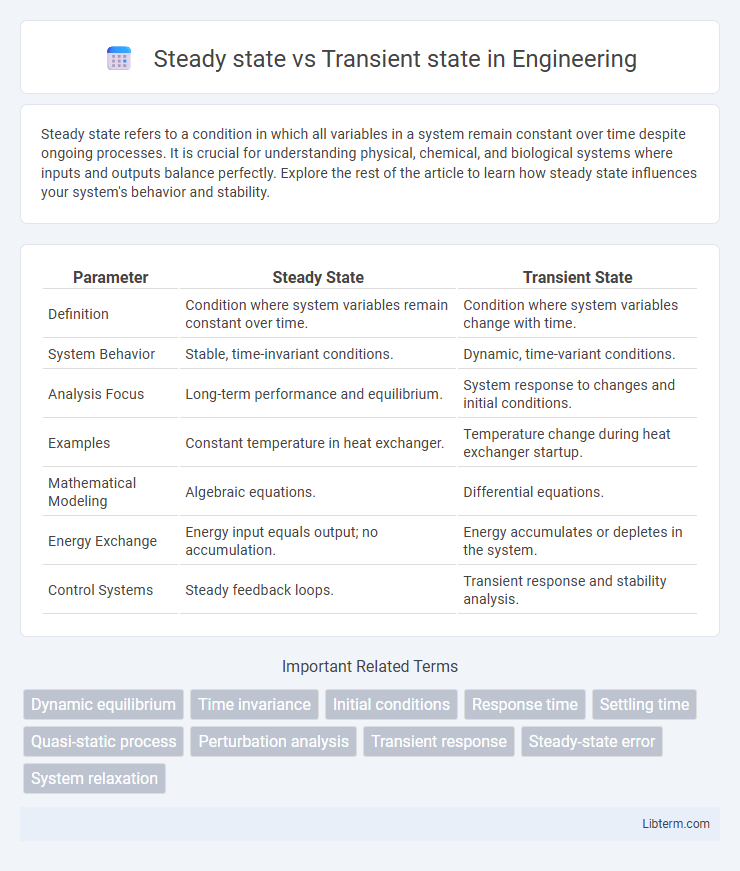Steady state refers to a condition in which all variables in a system remain constant over time despite ongoing processes. It is crucial for understanding physical, chemical, and biological systems where inputs and outputs balance perfectly. Explore the rest of the article to learn how steady state influences your system's behavior and stability.
Table of Comparison
| Parameter | Steady State | Transient State |
|---|---|---|
| Definition | Condition where system variables remain constant over time. | Condition where system variables change with time. |
| System Behavior | Stable, time-invariant conditions. | Dynamic, time-variant conditions. |
| Analysis Focus | Long-term performance and equilibrium. | System response to changes and initial conditions. |
| Examples | Constant temperature in heat exchanger. | Temperature change during heat exchanger startup. |
| Mathematical Modeling | Algebraic equations. | Differential equations. |
| Energy Exchange | Energy input equals output; no accumulation. | Energy accumulates or depletes in the system. |
| Control Systems | Steady feedback loops. | Transient response and stability analysis. |
Introduction to Steady State and Transient State
Steady state refers to the condition in a system where variables such as temperature, pressure, or concentration remain constant over time despite ongoing processes, indicating equilibrium. Transient state occurs when these variables change with time as the system moves from an initial condition toward steady state. Understanding the distinction between steady state and transient state is critical in fields like thermodynamics, chemical engineering, and control systems to analyze system behavior accurately.
Defining Steady State
Steady state refers to a condition in a system where all variables remain constant over time despite ongoing processes or inputs, indicating equilibrium in parameters like temperature, pressure, or concentration. Unlike transient state, where variables change dynamically until equilibrium is reached, steady state ensures stable operational performance and predictable system behavior. Engineering fields use steady state analysis to design and optimize systems such as chemical reactors, electrical circuits, and thermal systems for consistent output.
Understanding Transient State
Transient state refers to the period in dynamic systems where variables change from initial conditions to a stable steady state, characterized by time-dependent variations in system behavior. Understanding transient state involves analyzing system responses such as overshoot, settling time, and transient oscillations, which are critical in control systems, electrical circuits, and thermal processes. Accurate modeling of transient state dynamics facilitates improved system design, stability assessment, and performance optimization under non-equilibrium conditions.
Key Differences Between Steady State and Transient State
Steady state occurs when system variables remain constant over time, indicating equilibrium, while transient state involves variables changing dynamically before reaching that equilibrium. In steady state, energy and mass inputs equal outputs, whereas transient state features imbalances leading to time-dependent changes. The key difference lies in the system's stability: steady state reflects a stable condition, whereas transient state captures the process of moving toward stability.
Real-World Examples of Steady State
In electrical circuits, a steady state occurs when current and voltage remain constant over time, such as in a battery-powered flashlight after initial power-up. In chemical reactors, steady state is reached when reactant concentrations and temperature stay stable during continuous operation, exemplified by industrial ammonia synthesis. Traffic flow on highways also demonstrates steady state conditions when vehicle density and speeds maintain equilibrium during non-congested periods.
Real-World Examples of Transient State
Transient state occurs when a system is adjusting to a new equilibrium, such as the temperature change in a building after the heating system is turned on. In automotive engineering, transient states are observed during acceleration, where engine temperature and emissions fluctuate before stabilizing. Electrical circuits display transient behavior during power surges or when switching on devices, as voltages and currents temporarily deviate from steady values.
Importance in Engineering and Physics
Steady state conditions enable engineers and physicists to analyze systems with constant parameters, simplifying the design and prediction of performance in electrical circuits, thermal processes, and fluid dynamics. Transient state analysis captures the time-dependent behavior crucial for understanding system responses during startup, shutdown, or sudden disturbances, ensuring stability and safety in control systems and mechanical structures. Mastering both steady and transient states improves accuracy in modeling, optimization, and fault diagnosis across multidisciplinary engineering applications.
Mathematical Representation and Analysis
Steady state analysis involves solving algebraic equations where all system variables remain constant over time, typically represented as \( \mathbf{A} \mathbf{x} = \mathbf{b} \) in linear systems. Transient state analysis requires solving differential equations such as \( \frac{d\mathbf{x}}{dt} = \mathbf{A} \mathbf{x} + \mathbf{B} \mathbf{u} \), capturing time-dependent behavior before the system reaches equilibrium. Laplace transforms and eigenvalue methods are commonly employed for transient state solutions, providing insights into system stability and dynamic response.
Steady State vs Transient State in Control Systems
In control systems, steady state refers to the condition where system outputs remain constant over time despite continuous inputs, indicating stability and equilibrium. Transient state describes the period immediately after an input change where system outputs fluctuate and settle before reaching steady state. Understanding the differences between steady state and transient state is crucial for designing control systems with desired response times and stability margins.
Practical Applications and Implications
Steady state conditions are critical in industrial processes like chemical reactors and HVAC systems, where consistent output and energy efficiency are paramount. Transient state analysis is essential for the design and safety evaluation of systems during startup, shutdown, or upset conditions, ensuring stability and preventing damage. Understanding the differences between these states allows engineers to optimize performance, reduce operational risks, and improve system reliability across various applications.
Steady state Infographic

 libterm.com
libterm.com